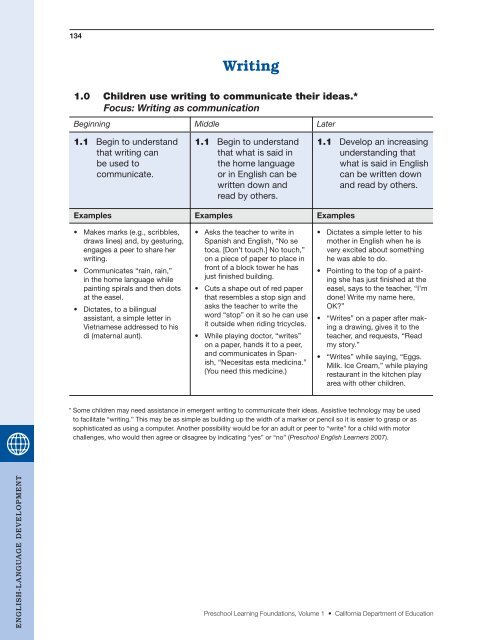California Preschool Learning Foundations - ECEZero2Three ...
California Preschool Learning Foundations - ECEZero2Three ...
California Preschool Learning Foundations - ECEZero2Three ...
Create successful ePaper yourself
Turn your PDF publications into a flip-book with our unique Google optimized e-Paper software.
ENGLISH-LANGUAGE DEVELOPMENT<br />
134<br />
Writing<br />
1.0 Children use writing to communicate their ideas.*<br />
Focus: Writing as communication<br />
Beginning Middle Later<br />
1.1 Begin to understand<br />
that writing can<br />
be used to<br />
communicate.<br />
1.1 Begin to understand<br />
that what is said in<br />
the home language<br />
or in English can be<br />
written down and<br />
read by others.<br />
Examples Examples Examples<br />
• Makes marks (e.g., scribbles,<br />
draws lines) and, by gesturing,<br />
engages a peer to share her<br />
writing.<br />
• Communicates “rain, rain,”<br />
in the home language while<br />
painting spirals and then dots<br />
at the easel.<br />
• Dictates, to a bilingual<br />
assistant, a simple letter in<br />
Vietnamese addressed to his<br />
dì (maternal aunt).<br />
• Asks the teacher to write in<br />
Spanish and English, “No se<br />
toca. [Don’t touch.] No touch,”<br />
on a piece of paper to place in<br />
front of a block tower he has<br />
just finished building.<br />
• Cuts a shape out of red paper<br />
that resembles a stop sign and<br />
asks the teacher to write the<br />
word “stop” on it so he can use<br />
it outside when riding tricycles.<br />
• While playing doctor, “writes”<br />
on a paper, hands it to a peer,<br />
and communicates in Spanish,<br />
“Necesitas esta medicina.”<br />
(You need this medicine.)<br />
1.1 Develop an increasing<br />
understanding that<br />
what is said in English<br />
can be written down<br />
and read by others.<br />
• Dictates a simple letter to his<br />
mother in English when he is<br />
very excited about something<br />
he was able to do.<br />
• Pointing to the top of a painting<br />
she has just finished at the<br />
easel, says to the teacher, “I’m<br />
done! Write my name here,<br />
OK?”<br />
• “Writes” on a paper after making<br />
a drawing, gives it to the<br />
teacher, and requests, “Read<br />
my story.”<br />
• “Writes” while saying, “Eggs.<br />
Milk. Ice Cream,” while playing<br />
restaurant in the kitchen play<br />
area with other children.<br />
* Some children may need assistance in emergent writing to communicate their ideas. Assistive technology may be used<br />
to facilitate “writing.” This may be as simple as building up the width of a marker or pencil so it is easier to grasp or as<br />
sophisticated as using a computer. Another possibility would be for an adult or peer to “write” for a child with motor<br />
challenges, who would then agree or disagree by indicating “yes” or “no” (<strong>Preschool</strong> English Learners 2007).<br />
<strong>Preschool</strong> <strong>Learning</strong> <strong>Foundations</strong>, Volume 1 • <strong>California</strong> Department of Education
















